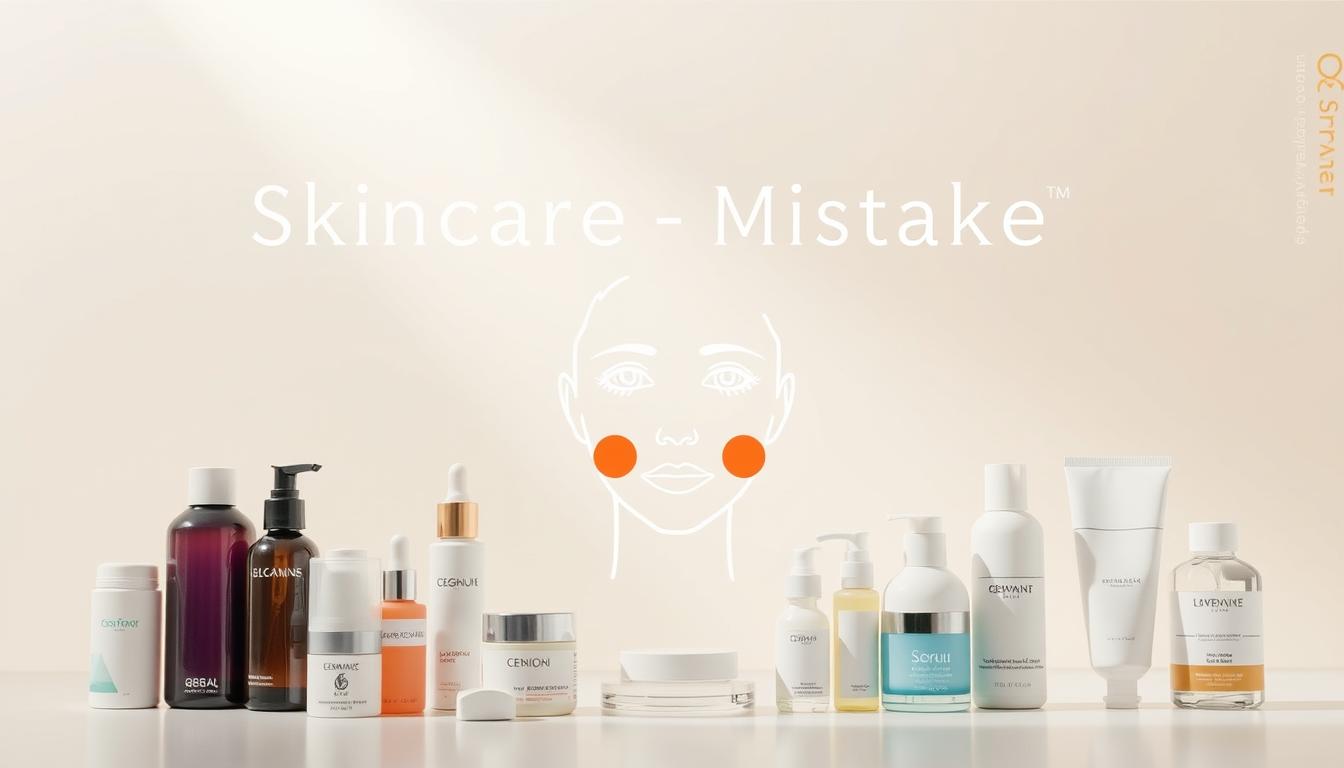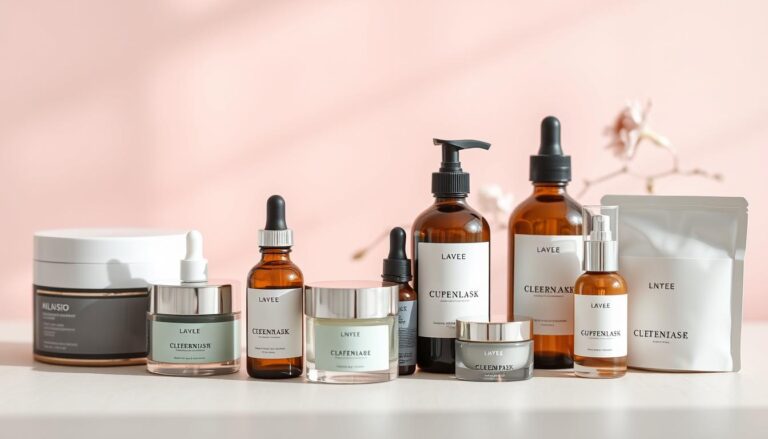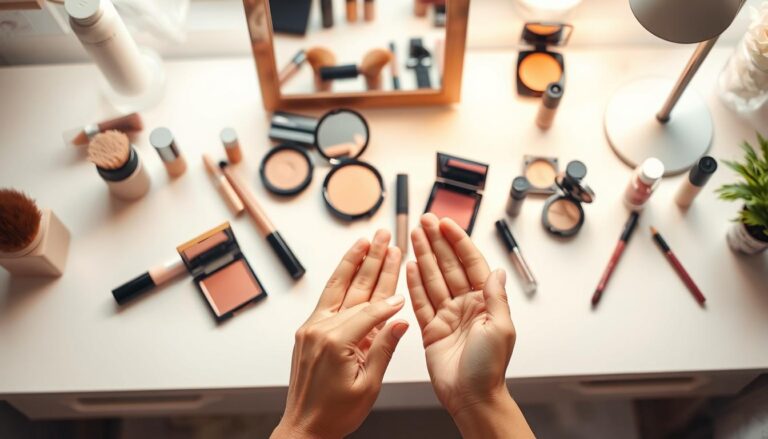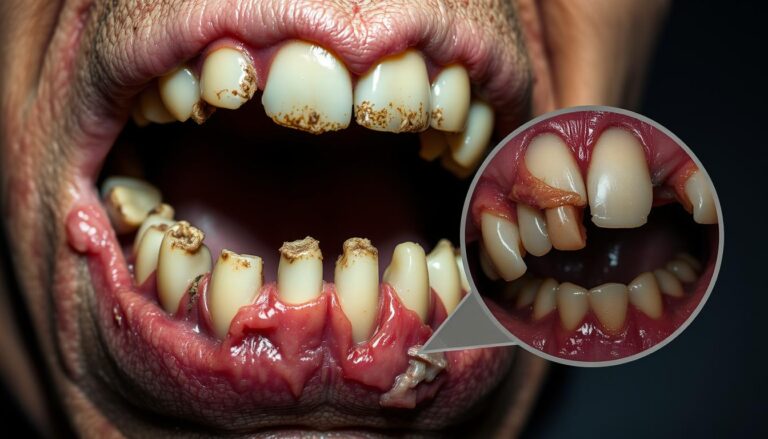Skincare: 7 Mistakes You’re Making and How to Fix Them
Table of Contents
Ever looked in the mirror and wondered why your skincare routine isn’t delivering the radiant results you crave? You’re not alone. Every day, countless individuals unknowingly sabotage their anti-aging efforts through simple beauty routines mistakes that can dramatically impact skin health.
At White Rock Dermatology, experts reveal that most skincare challenges stem from common misconceptions and improper techniques. Your skin is a delicate ecosystem that requires precision, knowledge, and gentle care to maintain its youthful glow.
This comprehensive guide will uncover the seven most critical skincare mistakes that might be preventing you from achieving your dream complexion. We’ll dive deep into understanding how small adjustments can transform your skincare approach and help you unlock your skin’s true potential.
Key Takeaways
- Understand the hidden pitfalls in your current skincare routine
- Learn scientifically-backed strategies for optimal skin health
- Discover how small changes can prevent premature aging
- Recognize the importance of personalized skincare approaches
- Master techniques that enhance your skin’s natural radiance
Understanding Common Skincare Blunders
Getting into skincare can seem like a big puzzle. Many people make mistakes that hurt their skin’s health and look. Knowing these common errors is the first step to a glowing, healthy face.
Signs You’re Making Skincare Mistakes
Your skin tells you when it’s upset. Look out for these signs:
- Persistent redness or irritation
- Unexpected breakouts
- Increased sensitivity
- Dry or tight feeling after cleansing
Impact on Skin Health
Skincare mistakes can harm your skin for a long time. Washing your face too much can take away its natural oils. This can make your skin produce more oil and lead to acne. For sensitive skin, wrong care can speed up aging and cause lasting harm.
“Your skin is a reflection of your overall skincare approach. Treat it with knowledge and care.” – Dermatology Experts
The Science Behind Skin Damage
It’s important to understand how your skin works. Washing your face too much can break its protective layer. This makes it more open to harm from the outside world. Natural ingredients can help fix this and support your skin’s healing.
- Cleanse no more than twice daily
- Use lukewarm water
- Choose gentle, natural ingredients
- Maintain consistent hydration
Pro tip: Listen to your skin. Each complexion is unique and needs special care.
The Dangers of Over-Cleansing Your Face

Keeping your skin healthy can be hard, especially when washing your face. Many people harm their skin by washing too much. The American Academy of Dermatology says to wash your face only twice a day to keep it balanced.
Washing too often can harm your skin. It takes away the natural oils that protect it. This makes your skin produce more oil, which can make acne worse and cause irritation.
- Symptoms of over-cleansing include:
- Increased skin dryness
- Redness and sensitivity
- Tight, uncomfortable skin feeling
- Unexpected breakouts
When your skin’s barrier is broken, moisturizers don’t work as well. Dermatologists advise using gentle cleansers and washing your face twice a day. If you have sensitive skin, wash once a day, in the evening, to remove dirt.
Gentle skincare is about quality, not quantity.
Knowing your skin type is key. If you have oily skin, you might need to wash more. But if your skin is dry or sensitive, be gentle. Always adjust your routine based on how your skin feels.
Why Over-Exfoliation is Harming Your Skin
Many people think that more exfoliation means better skin. But, this isn’t true. Over-exfoliating can really harm your skin, causing unexpected problems.
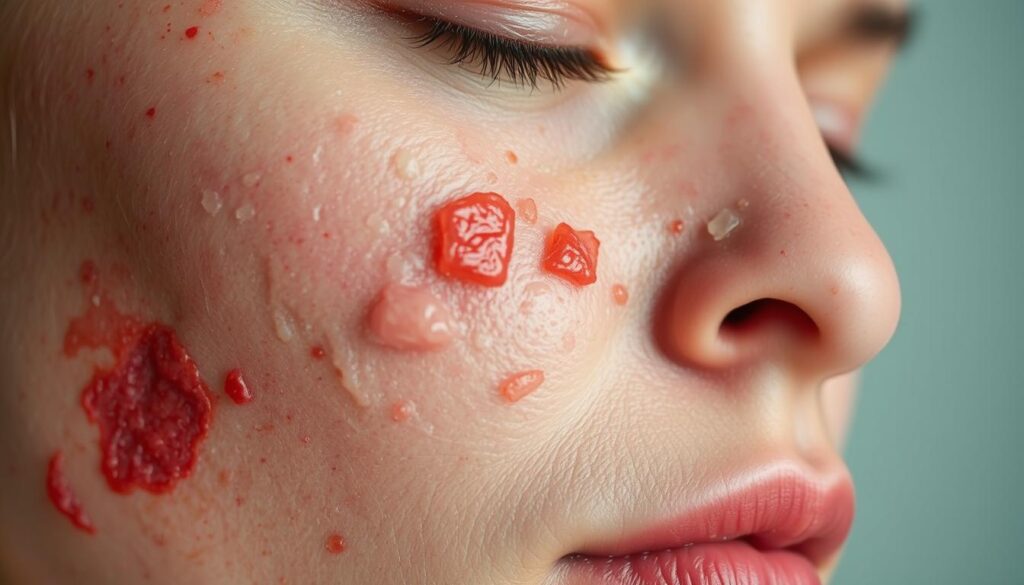
Exfoliation is good for your skin, but too much is bad. About 30% of people get redness and irritation from too much exfoliation.
Physical vs Chemical Exfoliation
Not all exfoliation is the same. Here’s what you need to know:
- Physical Exfoliation: Uses scrubs and tools to remove dead skin cells
- Chemical Exfoliation: Uses acids like AHA and BHA to break down skin cells
- Sensitive Skin: Usually does better with gentle chemical exfoliants
Finding the Right Exfoliation Schedule
Your exfoliation schedule depends on your skin type. Dermatologists suggest:
- Oily skin: Exfoliate up to 3 times a week
- Dry or sensitive skin: Exfoliate 1-2 times a week
- Mature skin: Use gentle exfoliants with AHA
Signs of Over-Exfoliated Skin
Look out for these signs that you’re exfoliating too much:
- Persistent redness and irritation
- Increased skin sensitivity
- Unexpected breakouts
- Shiny, tight-feeling skin
- Accelerated signs of aging
Remember, your skin needs balance. Gentle, careful exfoliation is essential for a healthy skincare routine. It keeps your skin glowing and protected.
Moisturizing Mistakes That Age Your Skin
Your skincare routine is crucial for fighting aging. Many people unknowingly harm their skin with common moisturizing errors. These mistakes can make you look older faster.
Dehydrated skin ages quickly, making you look older than you are. Studies show 62 percent of Americans use mature skin products. But not all moisturizers are good for you.
- Choose moisturizers specific to your skin type
- Understand your skin’s unique hydration needs
- Apply moisturizer correctly to maximize absorption
White Rock Dermatology suggests using lightweight, non-comedogenic moisturizers with hyaluronic acid for oily or combination skin. Even oily skin needs hydration to stay balanced.
| Skin Type | Recommended Moisturizer Characteristics |
|---|---|
| Oily Skin | Lightweight, water-based, non-comedogenic |
| Dry Skin | Rich, cream-based with ceramides |
| Combination Skin | Gel-cream formulations |
Not using enough moisturizer can cause dark circles, inflammation, and wrinkles. Seasonal changes and the environment also affect your skin’s hydration.
Consistent hydration is key to maintaining youthful, radiant skin.
Using high-quality skincare like SkinMedica TNS Advance+ Serum and HA5 Rejuvenating Hydrator helps. They support your skin’s moisture barrier and fight aging.
The Truth About Product Layering Order
Mastering your skincare routine is more than just the products you use. It’s about when and how you apply them. Knowing the right order can make your beauty routine more effective. It helps you get healthier, more radiant skin.
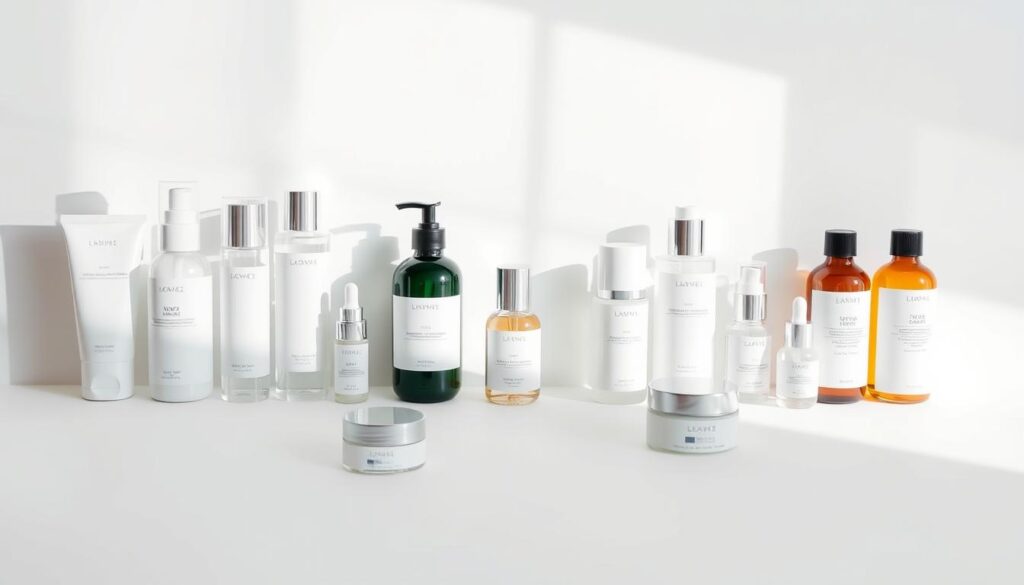
Correct Application Sequence
Apply your skincare products in a strategic order. This order helps them absorb better and work more effectively. Here’s the best sequence for great results:
- Cleanser
- Spot corrector
- Toner
- Essence
- Serums
- Eye cream
- Moisturizer
- Face oil
- SPF
Timing Between Products
How long you wait between applying products is key. Leaving your skin slightly damp helps products soak in better. Usually, wait 30-60 seconds between each product to let them absorb fully.
Product Compatibility Guide
| Product Type | Recommended Frequency | Best Practice |
|---|---|---|
| Retinoids | 1-2 times per week | Introduce gradually, apply before moisturizer |
| Acid-based Products | 2 times per week | Use sparingly to avoid over-exfoliation |
| Spot Correctors | Once daily | Apply on specific areas with targeted ingredients |
| SPF | Daily | Always the final step in morning skincare |
Your skincare journey is unique. These guidelines are a good start, but listen to your skin. Be ready to tweak your routine as needed.
Neglecting Essential Skincare Areas
Do you focus only on your face when it comes to skincare? Research shows that about 70% of people do. They ignore other important body parts that also need care.
Beauty routines often miss key areas. The neck, décolletage, hands, and feet are at risk of aging and damage. They need attention to stay healthy.
- Neck and Décolletage: Can show signs of aging up to 20 years earlier than the face
- Hands: Nearly 60% experience dryness, especially during colder months
- Feet: Around 40% do not apply specialized skincare products
Experts say to add these areas to your anti-aging skincare. Use sunscreen, moisturizer, and special treatments on them.
Here are some tips for better skincare:
- Use body oils for deep hydration on elbows and knees
- Apply hand cream regularly
- Protect neck and décolletage with SPF
- Exfoliate body skin 1-2 times weekly
Remember, skin is the largest organ of your body. A complete skincare routine can make your skin look better and reduce aging signs by up to 30%.
Sun Protection Errors and Solutions
Protecting your skin from harmful UV rays is more than just picking any sunscreen. It’s a key part of skincare that stops early aging and cuts down on skin damage risks.
Experts say only 25% of sunscreens are safe and work well. Choosing the right sunscreen is key for your skincare. Knowing common sun protection mistakes helps you build a better anti-aging plan.
Year-Round UV Protection Strategies
Many think sunscreen is only for summer. But UV rays harm skin all year. Dermatologists say to protect your skin every day, no matter the weather.
- Apply broad-spectrum sunscreen daily
- Use minimum SPF 30 protection
- Reapply every two hours when outdoors
- Protect skin even on cloudy days
Common SPF Application Mistakes
Sunscreen needs to be applied carefully. Common mistakes include:
- Not applying enough product
- Skipping hard-to-reach areas
- Applying sunscreen after moisturizer
- Failing to reapply throughout the day
Choosing the Right Sunscreen
Choosing the right sunscreen means knowing your skin type and how ingredients interact. Physical sunscreens with zinc oxide or titanium dioxide protect well without harmful chemicals.
Protect your skin today to prevent premature aging tomorrow.
When looking for sunscreen, pick ones that block both UVA and UVB rays. Think about your lifestyle, skin sensitivity, and any allergies to ingredients like oxybenzone or octinoxate.
The Connection Between Hydration and Oily Skin
Understanding how hydration affects oily skin can change your skincare routine. Many think that oily skin doesn’t need moisturizers. But, dehydrated skin can make your body produce more oil to make up for the lack of moisture.
Experts share interesting facts about skin hydration and controlling oil:
- Drinking eight glasses of water daily helps keep your skin hydrated
- Lightweight, non-comedogenic moisturizers balance your skin without clogging pores
- Hormonal changes can greatly affect how much sebum your skin produces
Getting the right moisturizers is key for oily skin. Choose products with hyaluronic acid and glycerin. They provide deep hydration without adding extra oil.
Proper hydration is the secret weapon in controlling oily skin and preventing breakouts.
Your diet also affects your skin. Eating foods full of omega-3 fatty acids, antioxidants, and lean proteins helps control oil. Avoid processed foods and sugar, as they can make your skin produce more oil.
Everyone’s skin is different. Try lightweight, oil-free moisturizers and see how your skin reacts. Keeping your skin hydrated and taking care of it gently is essential for balanced, healthy skin.
Conclusion
Your skincare journey is a personal adventure. It’s about discovering what works best for you. White Rock Dermatology suggests paying attention to how your skin reacts to different products and routines.
Understanding your skin’s needs helps you tailor your skincare. This way, you can address specific concerns and improve your skin’s health over time.
Natural ingredients and the right skincare products can change your daily routine. Many Americans face skin challenges, showing you’re not alone. The secret is to be consistent and adapt to your skin’s needs.
Skincare is about progress, not perfection. Every step, from sun protection to moisturizers, strengthens your skin. Be patient, learn, and stick to a routine that cares for your skin.
Your skincare journey is a lifelong commitment to self-care. By staying informed and proactive, you’ll find a skincare routine that suits you. Trust the process and enjoy the journey of caring for your skin.
FAQ
How often should I be cleansing my face?
Dermatologists say to wash your face twice a day. This is morning and night. But, it depends on your skin type. If your skin is sensitive or dry, clean it once a day, at night.
How do I know if I’m over-exfoliating my skin?
Over-exfoliation shows as sensitive skin, redness, and dryness. If your skin feels tight or looks shiny but feels rough, you’re doing too much. Most skin types need exfoliation 1-2 times a week.
What’s the correct order for applying skincare products?
Start with the thinnest product and go to the thickest. This order is cleanser, toner, serum, eye cream, moisturizer, and sunscreen in the day. Wait 30-60 seconds for each product to soak in before adding the next.
Do I really need to use sunscreen every day?
Yes, you do! UV rays harm your skin every day, even on cloudy or indoor days. Sunscreen with SPF 30 or higher is key. Reapply every 2 hours to protect your skin.
How can I tell if my skin is dehydrated versus just dry?
Dehydration is about water, while dryness is about oil. Dehydrated skin feels tight and looks dull. It can happen in any skin type. Use hydrating serums with hyaluronic acid to fix dehydration.
Which skin areas are most often neglected in skincare routines?
People often forget about their neck, décolletage, and hands. These areas age fast and need care. Use facial products on these areas and apply SPF to prevent damage.
How do I choose the right moisturizer for my skin type?
Pick a moisturizer based on your skin’s needs. Oily skin needs lightweight formulas. Dry skin needs richer creams. Combination skin might need different products. Choose ingredients that solve your skin problems.
Can I mix different active ingredients in my skincare routine?
Some ingredients work well together, but others can irritate. Vitamin C and vitamin E are good together, but not with retinol. Avoid mixing benzoyl peroxide with retinoids. If unsure, ask a dermatologist or start new products slowly.
To maintain your body’s fitness and get rid of excess fat, you need this wonderful nutritional supplement

